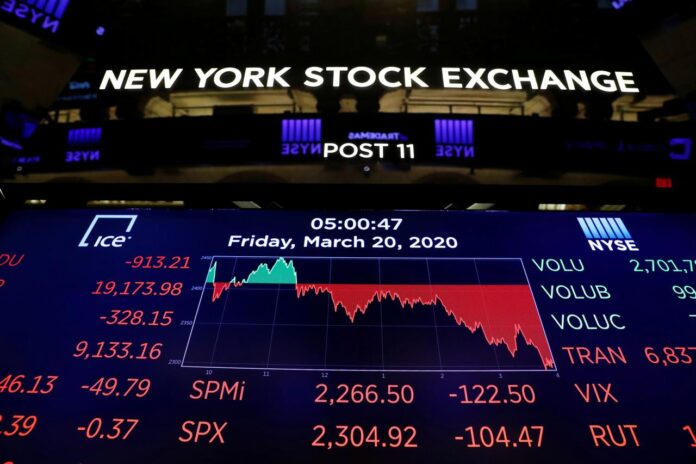How much damage has the coronavirus and the oil price collapse inflicted on global financial markets this year? Put simply, it has probably been the most destructive sell-off since the Great Depression.
The numbers have been staggering. $15 trillion has been wiped of world stock markets. Oil has slumped 60pc as Saudi Arabia and Russia have started a price war and emerging markets like Brazil, Mexico and South Africa have seen their currencies plummet more than 20pc.
Volatility and corporate borrowing market stress has spiked on worries that whole sectors could go bust, airlines have had half their value vaporised, while cratering economies risk a new wave of government debt crises.
“It has been like a train wreck,” Chris Dyer, Director of Global Equity at Eaton Vance, said. “You could see it coming and coming and coming, but you just couldn’t stop it happening.”
That carnage has seen 22pc and 24pc slumps for Wall Street’s Dow Jones and S&P 500, almost 25pc for MSCI 49-country world index .MIWD00000PUS and 27pc for London’s internationally exposed FTSE.
For reference, the record quarterly drop for Wall Street was 40pc in 1932 in the midst of the Great Depression. The fact that the S&P and Dow were at record highs back in mid February has made the crash this time seem more brutal.
Stocks in China, where the virus hit first, have faired relatively well in comparison with only an 11pc drop in dollar terms .CSI300, but the impact on other major emerging markets has been devastating as their main commodity markets, and currencies, have also collapsed.
Russian stocks, which topped the tables last year, have been routed 40pc in dollar terms. South Africa, which was stripped of its last investment grade credit rating on Friday, has fallen by the same percentage, though Brazil has been the worst, plunging 50pc.
A large part of that is down to some wild FX market moves. All three of those countries have seen their currencies lose over 20% this year, which also ties in to the commodity market carnage.
Brent crude oil has fallen by 62pc in the quarter to just $25 a barrel LCOc1. This was not only because of the coronavirus crisis, but also the price war between Saudi Arabia and Russia, which is putting their public finances at risk.
Industrial metals like copper, aluminium and steel have all dropped 15-22pc and some agricultural staples like coffee LRCc2 and sugar SBc1 are down 17pc and 10pc.
“These are truly historical moments in the history of financial markets. 2020 will go alongside 1929, 1987 and 2008 in the text books of financial market panics,” Deutsche Bank Strategist, Jim Reid, said.
GIVE ME SHELTER
So are they any places to shelter? Yes, but not many.
Sit-on-your-sofa-suited stocks like Netflix and Amazon have risen 10pc and 2.5pc respectively and some specialist medical equipment companies have surged.
Ultra-safe US government bonds have returned 13pc as the Federal Reserve cut US interest rates to effectively zero, leading a charge of around 62 interest rate cuts globally.
The dollar has rocketed against emerging market currencies. It had also shot up against the majors too, but has eased back over the last two weeks and will end the quarter only 2pc up against those bigger currencies.
This has left the Japanese yen, the other traditional FX safe-haven, with only a 0.4pc gain. The Swiss franc is down against the dollar, although it has climbed steeply against the euro and many other currencies.
Will April bring much relief? JPMorgan reckons the coronavirus will have pushed the world economy into a 12pc contraction in Q1 and with pandemic still spreading rapidly and keeping large parts of the global economy shuttered it is unlikely to get much easier in Q2.
The cavalry has arrived though. G20 governments have promised a $5 trillion revival effort, major central banks have cut rates and restarted asset purchases. Markets bounced big last week until Friday came and may still end Q1 on a relative high.
Stephane Monier, Chief Investment Officer of Lombard Odier, is looking to see whether infection rates in Europe and elsewhere peak as they did in Asia. If they do, markets could see a V-shaped 30pc recovery, although if they do not and cases jump in Asia again as lockdowns are lifted, it could be akin to a “war” situation which would impact the economy for 1-1/2 years.
“Our expectation is for a very volatile second quarter,” Monier said. “It is important to keep in liquid, high-quality assets.”





[…] post Three months that shook global markets appeared first on Profit by Pakistan […]